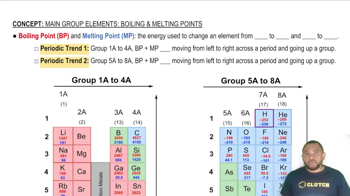Here are the essential concepts you must grasp in order to answer the question correctly.
Electron-Sea Model
The electron-sea model describes metals as a lattice of positive ions surrounded by a 'sea' of delocalized electrons. This model explains many properties of metals, such as electrical conductivity and malleability, as the free-moving electrons can easily respond to applied forces. The strength of metallic bonds in this model is influenced by the number of delocalized electrons, which contributes to hardness and melting points.
Recommended video:
Molecular Orbital (MO) Theory
Molecular Orbital (MO) theory, or band theory in the context of metals, describes how atomic orbitals combine to form molecular orbitals that can be occupied by electrons. In metals, these orbitals form bands that allow for the conduction of electricity. The energy gap between the valence band and the conduction band determines the electrical and thermal properties of the metal, influencing characteristics like hardness and melting point.
Recommended video:
Melting Point and Hardness Correlation
The melting point and hardness of a metal are often correlated with its bonding characteristics. Metals with strong metallic bonds, such as tungsten, typically exhibit high melting points and hardness due to the strong attraction between the delocalized electrons and the metal ions. In contrast, metals with weaker bonding, like gold, tend to be softer and have lower melting points, reflecting the differences in their electronic structures and bonding interactions.
Recommended video:
Boiling Point and Melting Point

 Verified step by step guidance
Verified step by step guidance


